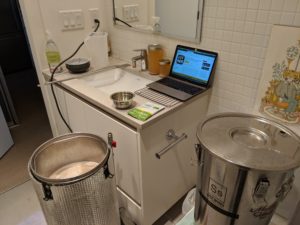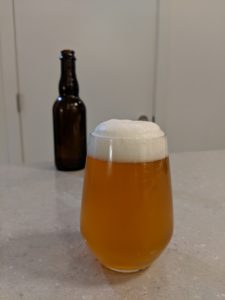Brew date: November 24, 2018
Bottle date: December 24, 2018
This is a recipe that was crowd-sourced on the Saison, Biere de Garde and Farmhouse Appreciation Society on Facebook to be a kind of best-of-both-worlds interpretation of both classic and modern saison characteristics. It has been brewed by a number of breweries in the US as well as a good handful of homebrewers I would imagine too. The grist and hop schedule were defined but the choice of yeast was left up to the brewer in order to bring a personal touch from each participating brewer.
I chose to use the Mad Fermentationist saison blend from Bootleg Biology, augmented with a bit of Funk Weapon III, as I had freshly saved this yeast from my last batch.
Without further ado, the recipe is as follows:
Target OG: 1.042
Estimated IBU: 35
70% Bohemian Pilsner malt (Weyermann) – 7.00 lbs
18% Wheat malt (unknown) – 1.80 lbs
12% Rye malt (Mecca Grade) – 1.20 lbs
18AAU of Tettnanger (in place of Strisselspalt) at 60 min (1.5 oz)
6 AAU of Tettnanger at 10 minutes (1.5 oz)
7 AAU of Motueka at 5 minutes (1.5 oz)
4 AAU of Hallertau Blanc at 5 miniutes (1 oz)
The use of low-alpha hops as bittering, while counter-intuitive in modern brewing, has been something I’ve increasingly become a fan of lately for saison as it lends a herbal backbone to the beer that only large amounts of hop matter will provide. The inclusion of Motueka and a more characterful Hallertau varietal gives a more modern hop aroma and flavour, while the rye helps the yeast in giving a spicy edge.
Above: My glamorous brew setup in the bathroom.
I followed a more involved mash schedule than usual in an effort to optimize the head retention of this beer – which could be in vain, since I pitched a blend with a decent amount of LAB in it.
Mash Schedule:
Dough in at 131F and stir thoroughly
Raise to 144F and hold 20 minutes
Raise to 148F and hold 10 minutes
Raise to 151F and hold 10 minutes
Raise to 161F and hold 30 minutes
Mash out at 170F, sparge with 170F water
I mashed with 4.15 gallons in the Grainfather; sparged with 3.65 approximately.
Mash was slower than usual, surely due to the rye malt – which, in addition to being huskless, was milled using my burr grinder on its most coarse setting as I didn’t have a mill to use on it. This produced a bit more “flour” than I would like to admit, but overall it didn’t seem too bad.
The slow mash could be why my gravity was way high on this batch compared to my normal extract – pre-boil gravity was a startling 1.050, when I was going for the mid 1.030’s. I added one gallon of water early in the boil but even still, the OG of this beer is 1.048. I intend to dilute a bit further at bottling.
After collecting about 5.4 gallons of 1.048 wort at 72F, I pitched roughly 200B cells of the yeast blend after about 15 seconds of pure O2. Left at ambient (around 68F), activity started around 18-20 hours in and was chugging along nicely at 24 hours.
Bottled December 24, 2018 at a FG of 1.004, primed to 2.7 volumes to account for a little more attenuation in bottle. I would have liked to let it stay in the carboy longer, but due to pipeline constraints I’m letting the rest of the conditioning happen in bottle.
Tasting Notes
Jan 24, 2019 – At one month in bottle, the carb is pretty good. Aroma is slightly cidery, but no apple on the taste – very herbal, comes across more malty and full bodied than Saison Doree did, which is surprising considering their similarities and matching water profiles. Heck, it’s also a good bit darker which I find surprising. Good touch of acidity but not too much. Still young so I’d say it’s promising.


